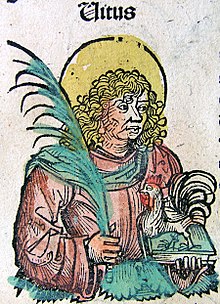Vitus | |
|---|---|
 Saint Vitus, from the Nuremberg Chronicle, 1493 | |
| Martyr, Holy Helper | |
| Born | c. 290 Mazzara del Vallo, Sicily |
| Died | c. 303 (age 12–13) Lucania, modern-day Basilicata, Italy |
| Venerated in | Roman Catholic Church Eastern Orthodox Church |
| Feast | 15 June |
| Attributes | Depicted in a cauldron, with a rooster or a lion |
| Patronage | Actors; comedians; Rijeka, Croatia; Czechoslovakia; dancers; dogs; epilepsy; Mazara del Vallo, Sicily; Forio, Ischia; oversleeping; Prague, Czech Republic; rheumatic chorea (Saint Vitus Dance); Serbia; snake bites; storms; Vacha, Germany; Zeven, Lower Saxony; the Gooi, Netherlands; E Clampus Vitus |
Vitus (/ˈvaɪtəs/), whose name is sometimes rendered Guy or Guido, was a Christian martyr from Sicily. His surviving hagiography is pure legend. The dates of his actual life are unknown.[1][2] He has for long been tied to the Sicilian martyrs Modestus and Crescentia but in the earliest sources it is clear that these were originally different traditions that later became combined.[3] The figures of Modestus and Crescentia are probably fictitious.[1]
According to his legend, he died during the Diocletianic Persecution in AD 303. In the Middle Ages, he was counted as one of the Fourteen Holy Helpers. In Germany, his feast was celebrated with dancing before his statue. This dancing became popular and the name "Saint Vitus Dance" was given to the neurological disorder Sydenham's chorea. It also led to Vitus being considered the patron saint of dancers and of entertainers in general.[4] He is also said to protect against lightning strikes, animal attacks and oversleeping. His feast day is celebrated on 15 June. In places where the Julian calendar is used, this date coincides, in the 20th and 21st centuries, with 28 June on the Gregorian calendar.
- ^ a b Basil Watkins, The Book of Saints: A Comprehensive Biographical Dictionary, 8th rev. ed. (Bloomsbury, 2016), p. 758.
- ^ Donald Attwater, The Avenel Dictionary of Saints (Avenel Books, 1981), p. 338.
- ^ David Hugh Farmer, The Oxford Dictionary of Saints, 5th rev. ed. (Oxford University Press, 2011), s.v. "Vitus (Guy), Modestus, and Crescentia".
- ^ "Saint Vitus". Saints.sqpn.com. Archived from the original on 8 August 2012. Retrieved 23 December 2013.